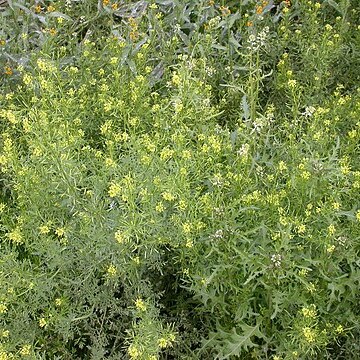Herbs annual or perennial, rarely shrubs. Trichomes short-stalked, dendritic, very rarely simple, sometimes mixed with glandular, clavate papillae. Stems erect or prostrate, simple or branched basally and/or apically. Basal leaves petiolate, withered by flowering, 2-or 3-pinnatisect, rarely 1-pinnate. Cauline leaves similar to basal. Racemes ebracteate or rarely basally bracteate, elongated or not in fruit. Fruiting pedicels slender, divaricate or erect. Sepals oblong or linear, erect or ascending, base of lateral pair not saccate. Petals yellow or rarely creamy white, as long as or longer than sepals; blade obovate or oblanceolate, rarely oblong, apex obtuse; claw obsolete or distinct. Stamens 6, tetradynamous; filaments not dilated at base; anthers oblong, obtuse at apex. Nectar glands confluent, subtending bases of all stamens; median glands present. Ovules 5-100 per ovary. Fruit dehiscent siliques or silicles, linear, oblong, clavate, or rarely elliptic, terete, sessile; valves with a prominent midvein, smooth or torulose; replum rounded; septum complete or perforated, membranous, veinless or with 1-3 longitudinal veins; style absent or rarely distinct and to 1 mm; stigma capitate, entire. Seeds uniseriate or biseriate, wingless, oblong or ellipsoid, plump; seed coat minutely reticulate, usually mucilaginous when wetted; cotyledons incumbent.
Sep ovate, obtuse; pet yellow, small, obovate or spatulate; anthers ovate or oblong; staminal glands minute or none; ovary cylindric; style very short, as thick as the ovary; stigma capitate; ovules numerous; frs linear or clavate, terete or slightly quadrangular, tipped with the very short persistent style; valves with a prominent midnerve; seeds elliptic or oblong; annual or biennial herbs; ± pubescent, some of or all the hairs branched; lvs 1–3 pinnate with numerous small segments. 40, mostly temp. New World. (Sophia)
Annual, sometimes biennial or perennial taprooted herbs. Hairs simple or branched or stellate, often glandular. Stems erect, leafy. Lvs finely pinnatisect to dissected. Racemes ebracteate. Sepals erect or spreading, not saccate. Petals usually pale yellow. Stamens 6, without appendages. Lateral nectaries 4, median 2, between stamen bases. Style very short; stigma capitate. Silique linear, dehiscent; valves convex with prominent median vein; beak 0. Seeds oblong or ovoid, not winged, in 1 or 2 rows per locule.
Annual or biennial herbs. Sepals erect or spreading, equal. Petals reduced to absent. Stamens 6. Median nectariferous glands present. Fruit a siliqua, dehiscent; valves with a distinct midvein. Seeds in 1 row per locule, mucous. Radicle incumbent.

